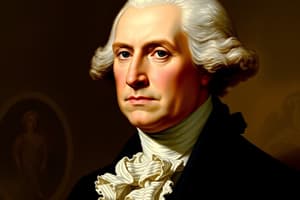Podcast
Questions and Answers
What was the first capital of the United States?
What was the first capital of the United States?
- Boston
- Philadelphia
- New York City (correct)
- Washington D.C.
Which of the following cabinet positions did Alexander Hamilton hold?
Which of the following cabinet positions did Alexander Hamilton hold?
- Secretary of War
- Secretary of State
- Secretary of the Treasury (correct)
- Attorney General
What was the primary purpose of Hamilton's Assumption Bill?
What was the primary purpose of Hamilton's Assumption Bill?
- To have the federal government assume state debts (correct)
- To reduce the federal government’s debt
- To increase individual state powers
- To establish a national bank
Who was the first Vice President of the United States?
Who was the first Vice President of the United States?
Which amendment guarantees the right to bear arms?
Which amendment guarantees the right to bear arms?
Why did Jefferson want the capital moved from Philadelphia?
Why did Jefferson want the capital moved from Philadelphia?
What was the primary cause of the Whiskey Rebellion?
What was the primary cause of the Whiskey Rebellion?
What was the outcome of the Treaty of Greenville in 1795?
What was the outcome of the Treaty of Greenville in 1795?
What was the main purpose of Pinckney's Treaty in 1795?
What was the main purpose of Pinckney's Treaty in 1795?
What was a major feature of the electoral process established during the election of 1796?
What was a major feature of the electoral process established during the election of 1796?
Flashcards are hidden until you start studying
Study Notes
Washington's Presidency (1789-1797)
- George Washington inaugurated as the first president on April 30, 1789.
- First U.S. capital was New York City for one year, then moved to Philadelphia for ten years, finally settled in Washington D.C.
- Established the presidential cabinet with four key positions:
- Secretary of State: Thomas Jefferson (Virginia)
- Secretary of the Treasury: Alexander Hamilton (New York)
- Secretary of War: Henry Knox (Massachusetts)
- Attorney General: Edmund Randolph (Virginia)
- First Vice President was John Adams (Massachusetts), not part of the cabinet.
- Cabinet members represented the largest states to ensure significant influence in the executive branch.
Bill of Rights
- First Congress's primary task was to create the Bill of Rights.
- Amendments require approval from three-fourths of the states; ten amendments were ratified.
- Key amendments included:
- First Amendment: Freedom of speech
- Second Amendment: Right to bear arms
- Third Amendment: No quartering of troops
- Tenth Amendment: Powers not granted to the federal government are reserved for states.
Hamilton's Financial Plans
- Alexander Hamilton aimed to address national debt, which totaled $54 million.
- Proposed the Assumption Bill (1790) to have the federal government assume state debts, fostering national unity.
- Thomas Jefferson and James Madison opposed this bill, prioritizing states' rights over national consolidation.
- After negotiations, the capital was moved to Washington D.C., influencing support for Hamilton's financial plan.
Creation of the Bank
- Hamilton argued for a federally controlled bank to stabilize the economy; Madison deemed it unconstitutional.
- Bank of the United States established in 1791, funded primarily by wealthy investors.
- The bank operated under a 20-year charter set to expire in 1811, contributing to rapid economic recovery.
Tariffs and Excise Taxes
- Tariff of 1789 imposed taxes on imported goods to raise revenue.
- Excise tax introduced, notably on whiskey, leading to significant farmer discontent.
Whiskey Rebellion (1794)
- Occurred in Pennsylvania as a violent protest against the whiskey tax.
- Washington deployed 13,000 troops to quell the rebellion, which ended before they arrived, asserting federal authority.
Native American Treaties and Conflicts
- Battle of Fallen Timbers (1794) marked the end of the Northwest Indian War, leading to a Native American defeat.
- Treaty of Greenville (1795) resulted in Native Americans ceding land in Ohio for $10,000.
Foreign Relations and Neutrality
- Neutrality Proclamation (1793) avoided entanglement in the French Revolution, prioritizing national debt management.
- Washington faced criticism for not supporting France, causing tension with pro-France Jefferson, who eventually resigned.
Pinckney's Treaty (1795)
- Treaty between the U.S. and Spain resolving trade issues.
- Americans gained access to New Orleans for trade, providing a crucial outlet for goods moving along the Mississippi River.
End of Washington's Presidency
- Washington chose not to seek a third term, establishing a precedent for future presidents.
- Election of 1796 marked the first significant presidential election, resulting in John Adams becoming the second president (1797-1801).
Studying That Suits You
Use AI to generate personalized quizzes and flashcards to suit your learning preferences.



